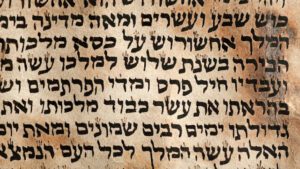The author to the Hebrews wrote that “faith is the assurance of things hoped for, the conviction of things not seen.” (Hebrews 11:1) At Easter, we remember things we have not seen but which we nevertheless believe took place. This gift of faith is a gift of God:
For by grace you have been saved through faith. And this is not your own doing; it is the gift of God, not a result of works, so that no one may boast. (Ephesians 2:8-9)
And yet, the Apostle John wrote his gospel “so that you may believe that Jesus is the Christ, the Son of God, and that by believing you may have life in his name.” (John 20:31) The Apostle Luke similarly wrote so that Theophilus “may have certainty concerning the things you have been taught.” (Luke 1:4)
What is beautiful, then, is the fact that God’s gift of faith does not exist in a vacuum. God could have given us faith in His Son without also providing any evidence, yet He did not, and at Easter we are reminded of a number of proofs that can comfort us in our faith. One of these proofs was obviously a favourite of James Montgomery Boice. In one of his Easter sermons which is now reprinted in both his commentary series on John and in The Christ of the Empty Tomb, Boice highlights the evidence that awaited John and Peter as they made their mad dash to the tomb of Jesus.
A Running Response
One such proof was found early on that first Easter Sunday. Mary Magdalene races to deliver news to the Disciples that the stone had been rolled away. Upon hearing her news, Peter and John race to the tomb, leaving Mary in their wake:
So she ran and went to Simon Peter and the other disciple, the one whom Jesus loved, and said to them, “They have taken the Lord out of the tomb, and we do not know where they have laid him.” So Peter went out with the other disciple, and they were going toward the tomb. Both of them were running together, but the other disciple outran Peter and reached the tomb first. (John 20:2-4)
It’s worth stopping here to ask a question: When you first heard the news of Jesus’ resurrection, what was your response? Did you stall and express disbelief? Did you turn your back on the news and go about your life as if nothing had happened? Or did you drop everything and race towards the tomb to see for yourself?
When you first heard the news of Jesus’ resurrection, what was your response? Did you stall and express disbelief? Did you turn your back on the news and go about your life as if nothing had happened? Or did you drop everything and race towards the tomb to see for yourself?
At the same time as Peter and John were running towards the tomb, another group of men were also making haste away from the tomb. The soldiers appointed by the Jewish chief priests to guard the tomb had recovered from the appearance of the angel of the Lord and rushed away to inform the chief priests of “all that had taken place.” (Matthew 28:11)
One event, two lots of messengers, one message, two very different responses.
Mary’s report to John and Peter immediately sent them off to see for themselves what had happened—a response which led to belief in the risen Saviour. The guards’ report to the chief priests, on the other hand, led to a cover-up which was believed by many for over a century (if not, in fact, millennia).
Note also that the chief priests did not disbelieve, they chose instead to ignore. Christianity today is not nearly so often disbelieved as it is simply ignored—its history, its evidence, its story, and its truth dismissed as unimportant or irrelevant.
A Nearly Empty Tomb
When John and Peter arrived at the tomb, we expect to hear the Bible authors speak rapturously about the tomb’s emptiness. However, John, the only Gospel writer to witness the empty tomb, says nothing about the tomb’s emptiness and speaks instead of that which was left behind in the tomb.
Both of them were running together, but the other disciple outran Peter and reached the tomb first. And stooping to look in, he saw the linen cloths lying there, but he did not go in. Then Simon Peter came, following him, and went into the tomb. He saw the linen cloths lying there, and the face cloth, which had been on Jesus’ head, not lying with the linen cloths but folded up in a place by itself. Then the other disciple, who had reached the tomb first, also went in, and he saw and believed. (John 20:4-8)
John reaches the tomb first. This single reference is, for me, one of my favourite verses in the whole Bible. We know John is the one writing this account and we know he was likely writing this many years after the events took place. This is an old man, writing about the greatest day in human history, and he takes a couple of pen strokes to let everyone know that he used to be faster than Peter. It’s beautifully human.
What is also beautifully human is the way in which the disciples respond to what they find. The tomb is not empty—contrary to popular belief: The funeral clothes Jesus was buried in remain, and something about their presence and placement cause John to believe.
To many people today the nuance of what John describes is lost—which is not surprising, considering that it relies heavily on Jewish burial customs. We see something of it in the verses in the immediately-preceding chapter, where Joseph of Arimathea and Nicodemus bury Jesus together, wrapping his body in linen cloths and “a mixture of myrrh and aloes, about seventy-five pounds in weight … as is the burial custom of the Jews.” (John 19:39-40)
A second point is made by Henry Latham in his book The Risen Master, published in 1901. Latham, who had witnessed burial customs in Constantinople during the 19th Century, described the funeral rites he observed; James Montgomery Boice writes that “Latham noticed that the bodies were wrapped in linen cloths in such a manner as to leave the face, the neck, and the upper part of the shoulders bare. The upper part of the head was covered by a cloth that had been twirled about it like a turban.”[1]
Funeral customs do not change quickly and can sometimes stay the same over centuries and millennia, and we see hints of this first, in Luke 7, where Jesus encounters a funeral procession in a town called Nain and raises a young man from the dead. Immediately, “the dead man sat up and began to speak” (Luke 7:15)—something that would have been incredibly difficult if he were wrapped head to toe. Secondly, and more decisively, when Jesus raises Lazarus from death, he emerges from the tomb “his hands and feet bound with linen strips, and his face wrapped with a cloth.” (John 11:44)
Which brings us back to the nearly empty tomb of Jesus, and what John remembers seeing that day. Peter and John “saw the linen cloths lying there, and the face cloth, which had been on Jesus’ head, not lying with the linen cloths but folded up in a place by itself.” (John 20:6-7)
A New Body
John and Peter entered the tomb and did not find linen and spices strewn about the empty tomb as if Jesus had been resuscitated—life returning to a body claustrophobically encased in linen, cinematically scrambling to escape the confines of his funeral wrappings. Rather, as John Stott puts it Christ’s whole body has “passed miraculously from death into an altogether new sphere of existence … [it] passed through the graveclothes, as it was later to pass through closed doors, leaving them untouched and almost undisturbed.”[2]
This is what John describes for us—revealing exactly what we would expect under such a situation: The linen burial cloths are left lying there, and no mention of the spices are made, and lying on its own, “not lying with the linen cloths but folded up in a place by itself,” rests the face covering.
How did Jesus escape the confines of his burial clothes and the tomb? In one way, it doesn’t really matter—we must simply believe that He did. But God did not stop there, and instead gave us the answer through the words of one who had seen and believed. Jesus’ body was no longer what it once was but had become the new body all who believe will one day inherit. God gave us proof of what happened in the same breath as He gave us proof of what will happen.
When we celebrate Jesus’ resurrection from the dead this Sunday, we can not only trust that Jesus rose from the dead, but we can imagine what happened in those moments that followed God’s powerful victory over death—freed of human sin, Jesus stepped into a new body.
[1] The Christ of the Empty Tomb, James Montgomery Boice, p. 79
[2] Basic Christianity, John R.W. Stott, p. 53















